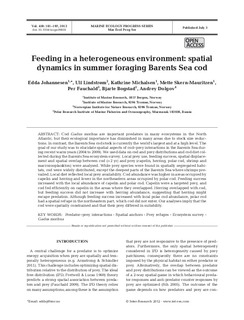| dc.description.abstract | Cod Gadus morhua are important predators in many ecosystems in the North Atlantic, but their ecological importance has diminished in many areas due to stock size reductions. In contrast, the Barents Sea cod stock is currently the world’s largest and at a high level. The goal of our study was to elucidate spatial aspects of cod−prey interactions in the Barents Sea during recent warm years (2004 to 2009). We used data on cod and prey distributions and cod diet collected during the Barents Sea ecosystem survey. Local prey use, feeding success, spatial displacement and spatial overlap between cod (>2 yr) and prey (capelin, herring, polar cod, shrimp and macrozooplankton) were analysed. While prey species were found in spatially segregated habitats, cod were widely distributed, except the deepest parts of the Barents Sea where shrimps prevailed. Local diet reflected local prey availability. Cod abundance was higher in areas occupied by capelin and herring and lower in the northeastern areas occupied by polar cod. Feeding success increased with the local abundance of capelin and polar cod. Capelin were a targeted prey, and cod fed efficiently on capelin in the areas where they overlapped. Herring overlapped with cod, but feeding success did not increase with herring abundance, suggesting that herring might escape predation. Although feeding success increased with local polar cod abundance, polar cod had a spatial refuge in the northeastern part, which cod did not enter. Our analyses imply that the cod were spatially constrained and that their prey differed in suitability. | no_NO |
